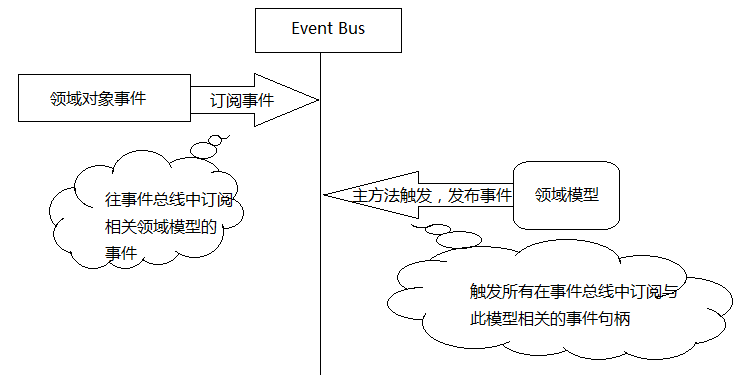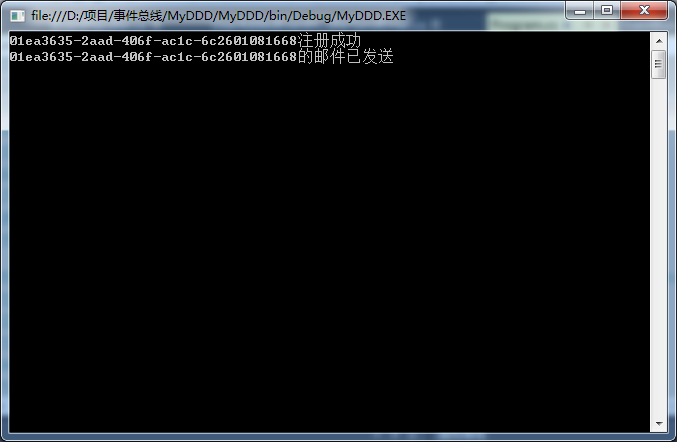领域事件和事件总线
- 何为领域驱动设计?
2004年著名建模专家Eric Evans发表了他最具影响力的书籍:《Domain-Driven Design: Tackling Complexity in the Heart of Software》(中文译名:领域驱动设计:软件核心复杂性应对之道),书中提出了领域驱动设计(简称 DDD)的概念。
领域驱动设计事实上是针对OOAD的一个扩展和延伸,DDD基于面向对象分析与设计技术,对技术架构进行了分层规划,同时对每个类进行了策略和类型的划分。
领域模型是领域驱动的核心。采用DDD的设计思想,业务逻辑不再集中在几个大型的类上,而是由大量相对小的领域对象(类)组成,这些类具备自己的状态和行为,每个类是相对完整的独立体,并与现实领域的业务对象映射。领域模型就是由这样许多的细粒度的类组成。基于领域驱动的设计,保证了系统的可维护性、扩展性和复用性,在处理复杂业务逻辑方面有着先天的优势。
摘自:http://kb.cnblogs.com/page/112298/
- 领域模型的种类?
- 失血模型:模型仅仅包含数据的定义和getter/setter方法,业务逻辑和应用逻辑都放到服务层中。这种类在Java中叫POJO,在.NET中叫POCO。
- 贫血模型:贫血模型中包含了一些业务逻辑,但不包含依赖持久层的业务逻辑。这部分依赖于持久层的业务逻辑将会放到服务层中。可以看出,贫血模型中的领域对象是不依赖于持久层的。
- 充血模型:充血模型中包含了所有的业务逻辑,包括依赖于持久层的业务逻辑。所以,使用充血模型的领域层是依赖于持久层,简单表示就是 UI层->服务层->领域层<->持久层。
- 胀血模型:胀血模型就是把和业务逻辑不想关的其他应用逻辑(如授权、事务等)都放到领域模型中。我感觉胀血模型反而是另外一种的失血模型,因为服务层消失了,领域层干了服务层的事,到头来还是什么都没变。
- 领域事件和事件总线

- 总管对象(事件总线) EventBus
主要职责是管理领域模型的所有事件,通过Dictionary<Type,List<object>> _dicEventHandler=new Dictionary<Type, List<object>>();主要包括
- Subscribe订阅相关的领域对象事件
- Publish 触发所有在事件总线上的领域对象事件句柄
using System;
using System.Collections.Generic;
using System.Linq;
using System.Text;
using System.Threading.Tasks;
namespace MyDDD
{
/// <summary>
/// 事件总线
/// </summary>
public class EventBus
{
/// <summary>
/// 事件总线对象
/// </summary>
private static EventBus _eventBus=null;
/// <summary>
/// 领域模型事件句柄字典,用于存储领域模型的句柄
/// </summary>
private static Dictionary<Type,List<object>> _dicEventHandler=new Dictionary<Type, List<object>>();
/// <summary>
/// 附加领域模型处理句柄时,锁住
/// </summary>
private readonly object _syncObject = new object();
/// <summary>
/// 单例事件总线
/// </summary>
public static EventBus Instance
{
get
{
return _eventBus ?? (_eventBus=new EventBus());
}
}
private readonly Func<object, object, bool> _eventHandlerEquals = (o1, o2) =>
{
return true;
};
#region 订阅事件
public void Subscribe<TEvent>(IEventHandler<TEvent> eventHandler) where TEvent : IEvent
{
//同步锁
lock (_syncObject)
{
//获取领域模型的类型
var eventType = typeof (TEvent);
//如果此领域类型在事件总线中已注册过
if (_dicEventHandler.ContainsKey(eventType))
{
var handlers = _dicEventHandler[eventType];
if (handlers != null)
{
handlers.Add(eventHandler);
}
else
{
handlers=new List<object>
{
eventHandler
};
}
}
else
{
_dicEventHandler.Add(eventType, new List<object> { eventHandler });
}
}
}
#endregion
#region 宣布事件
public void Publish<TEvent>(TEvent tEvent, Action<TEvent, bool, Exception> callback) where TEvent:IEvent
{
var eventType = typeof (TEvent);
if (_dicEventHandler.ContainsKey(eventType) && _dicEventHandler[eventType] != null &&
_dicEventHandler[eventType].Count > 0)
{
var handlers = _dicEventHandler[eventType];
try
{
foreach (var handler in handlers)
{
var eventHandler = handler as IEventHandler<TEvent>;
eventHandler.Handle(tEvent);
callback(tEvent, true, null);
}
}
catch (Exception ex)
{
callback(tEvent, false, ex);
}
}
else
{
callback(tEvent, false,null);
}
}
#endregion
}
}
- 领域对象
领域对象通过实现IEvent接口,标记此领域对象可以往事件总线中订阅与自己相关的领域对象事件。
用户注册领域对象
using System;
using System.Collections.Generic;
using System.Linq;
using System.Text;
using System.Threading.Tasks;
namespace MyDDD
{
/// <summary>
/// 领域模型对象
/// </summary>
public class UserGenerator:IEvent
{
/// <summary>
/// 用户Id
/// </summary>
public Guid UserId { get; set; }
}
}
- 领域对象事件句柄
领域对象事件句柄是领域对象发生变化时,通知EventBus触发所有的事件句柄
public void Publish<TEvent>(TEvent tEvent, Action<TEvent, bool, Exception> callback) where TEvent:IEvent
用户注册发送Email的事件句柄
using System;
using System.Collections.Generic;
using System.Linq;
using System.Text;
using System.Threading.Tasks;
namespace MyDDD
{
/// <summary>
///
/// </summary>
public class UserAddedEventHandlerSendEmail : IEventHandler<UserGenerator>
{
public void Handle(UserGenerator tEvent)
{
Console.WriteLine(string.Format("{0}的邮件已发送", tEvent.UserId));
}
}
}
例子说明:当用户注册完成后,通知EventBus,由EventBus触发相应操作,发送Email或者其他操作。
这样的好处用户注册是主业务,其他属于拓展,增加或减少需求,只需要往EventBus上订阅或取消事件即可。
using System;
using System.Collections.Generic;
using System.Linq;
using System.Text;
using System.Threading.Tasks;
namespace MyDDD
{
class Program
{
static void Main(string[] args)
{
EventBus.Instance.Subscribe(new UserAddedEventHandlerSendEmail());
var userGenerator = new UserGenerator{UserId = Guid.NewGuid()};
Console.WriteLine("{0}注册成功",userGenerator.UserId);
EventBus.Instance.Publish(userGenerator, CallBack);
Console.ReadKey();
}
public static void CallBack(UserGenerator userGenerator, bool result, Exception ex)
{
}
}
}








【推荐】国内首个AI IDE,深度理解中文开发场景,立即下载体验Trae
【推荐】编程新体验,更懂你的AI,立即体验豆包MarsCode编程助手
【推荐】抖音旗下AI助手豆包,你的智能百科全书,全免费不限次数
【推荐】轻量又高性能的 SSH 工具 IShell:AI 加持,快人一步
· 基于Microsoft.Extensions.AI核心库实现RAG应用
· Linux系列:如何用heaptrack跟踪.NET程序的非托管内存泄露
· 开发者必知的日志记录最佳实践
· SQL Server 2025 AI相关能力初探
· Linux系列:如何用 C#调用 C方法造成内存泄露
· 无需6万激活码!GitHub神秘组织3小时极速复刻Manus,手把手教你使用OpenManus搭建本
· Manus爆火,是硬核还是营销?
· 终于写完轮子一部分:tcp代理 了,记录一下
· 别再用vector<bool>了!Google高级工程师:这可能是STL最大的设计失误
· 单元测试从入门到精通
2015-08-01 消息中间件